
Edward Winter
(2008, with additions)

From page 10 of The Observer (London), 13 August 1922:
‘Capablanca has drawn up a set of rules for future championship matches, and all the great masters now playing at the London Congress have agreed to them, namely Alekhine, Bogoljubow, Maróczy, Réti, Rubinstein, Tartakower and Vidmar. It is a long document of 21 clauses ...’
As discussed in chapter nine of our book on Capablanca, there exist slightly different versions of the Rules. They are set out in full below.
Pages 185-186 of the December 1923 American Chess Bulletin:

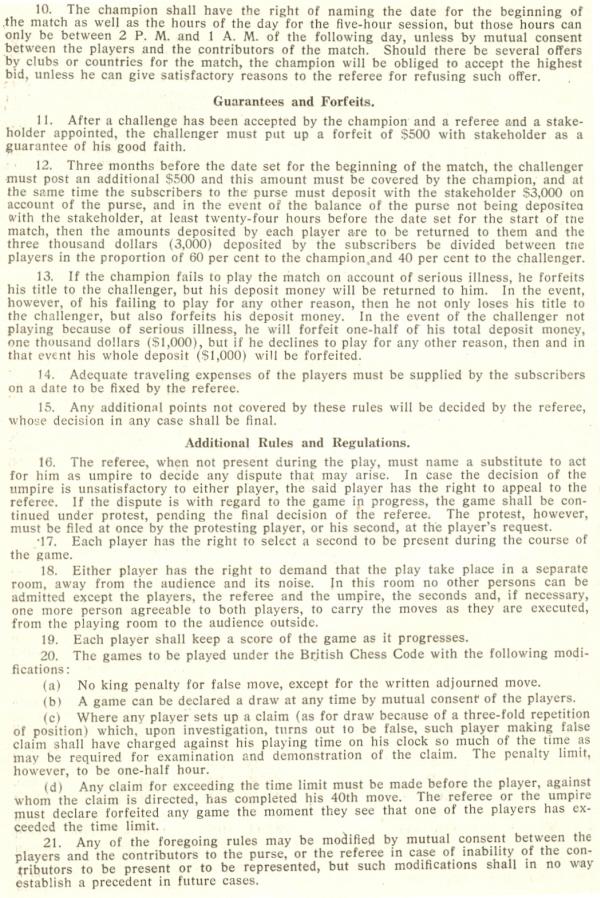
Pages 133-134 of the November 1926 American Chess Bulletin:
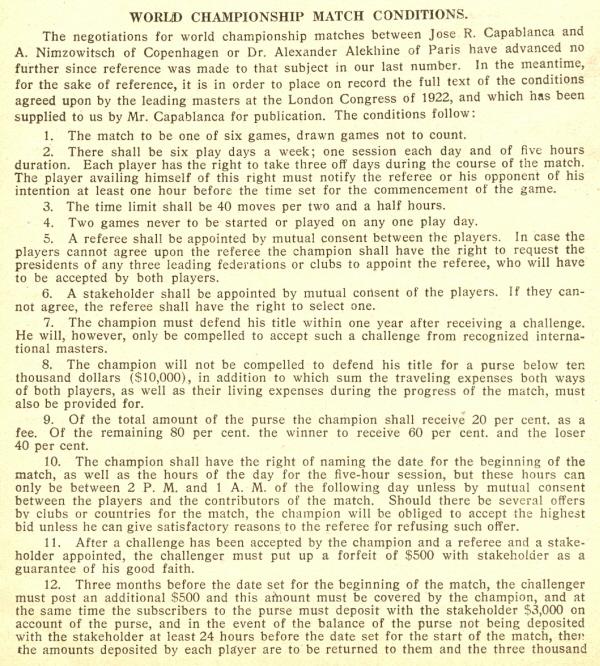

Pages 125-126 of the January 1927 Chess Amateur:
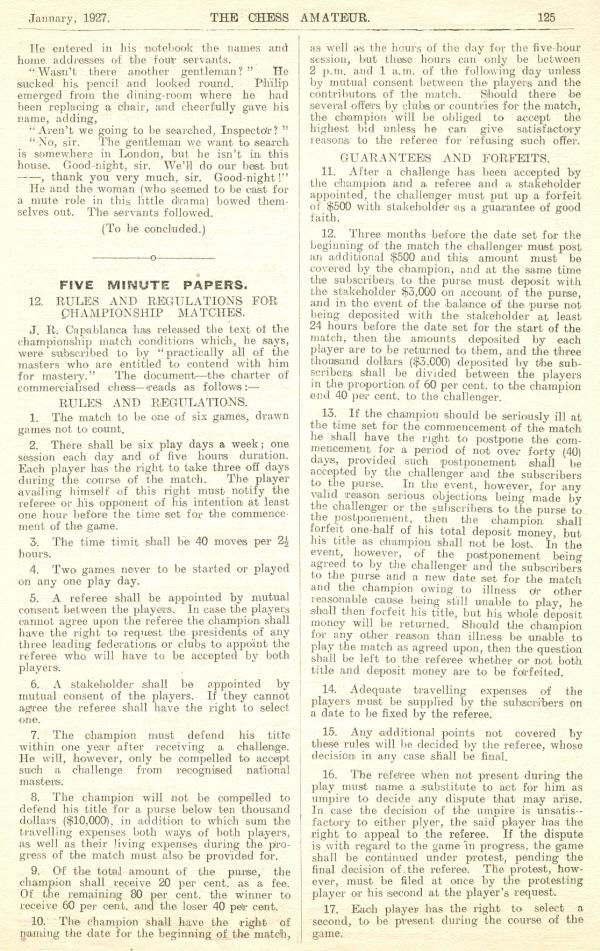
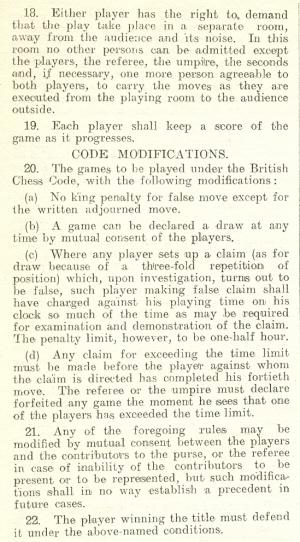
Finally, a copy of the Rules sent to us in the late 1980s by the Manhattan Chess Club:
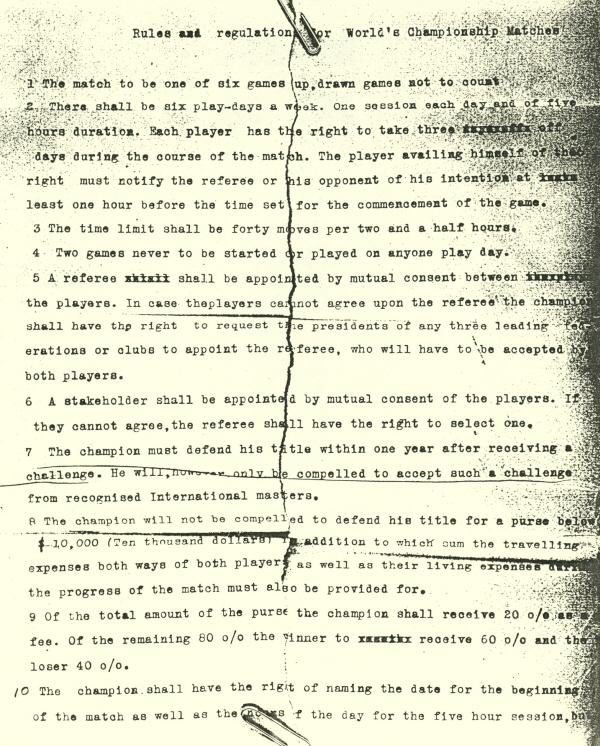

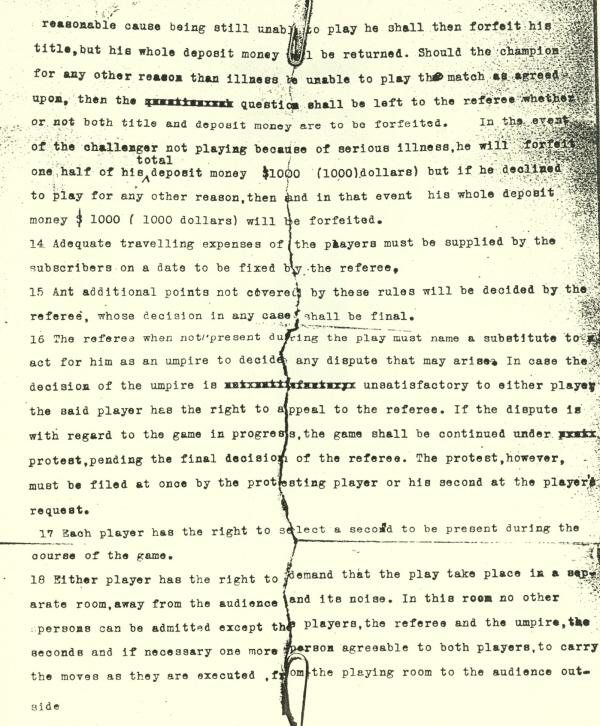
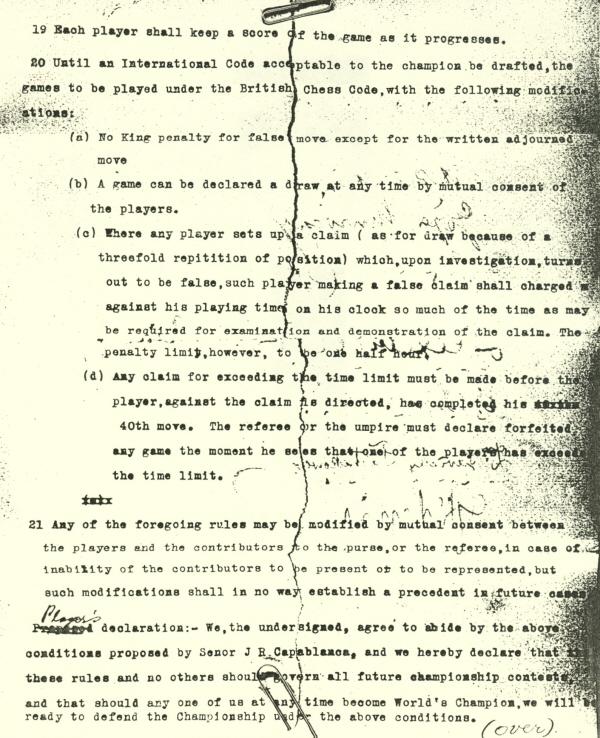

Hugh Myers (Davenport, IA, USA) writes:
‘I reject the casting of all blame on Alekhine for there not having been a Capablanca rematch. See the Myers Openings Bulletin number 33, page 25. Earlier than 1938 I’m sure that there would have been a rematch if Capablanca had simply come up with 10,000 dollars in gold – and why should that have been impossible, even during the Depression, at a time when many people still believed that he was the strongest player of all time?’
(801)
And:
‘I’m tired of reading things like the following quotes written by people who don’t know enough about chess history to say anything about it (and they weren’t the first): “Alekhine used every possible pretext to avoid playing a match with anyone who might have presented a real danger to him. Thus, Capablanca, the logical choice for a rematch, was kept at a distance by means of insults and impossibly high financial demands” (J. Marfia, 1981), and “(Alekhine) used his friendship with Capablanca to contract a world title match ahead of more qualified candidates, and following his win, he avoided a return match” (J. Graham, 1984). However – Alekhine accepted Capablanca’s challenge to a return match, under the same conditions as their 1927 match (BCM, January 1930). In The Times (London) of 11 August 1930, Tinsley reported on a contact with Capablanca. Negotiations for the match – for the same stakes as in 1927 – had been suspended. Capablanca hadn’t been able to come up with the money; he hoped to raise it in the U.S in late 1930. That doesn’t conflict with the 9/30 Deutsche Schachzeitung report, except that the October 1929 500 dollars deposit shouldn’t be called a “stake”; that was just a deposit towards the stakes to show the sincerity of the challenge that the BCM reported in 1/30. Actual stakes would have to have been $10,000 dollars, or perhaps £2,000.
Capablanca repeated his challenge in February 1931, first asking for a match in the Spring, then for one in the Winter of 1931-32. Considering that he was to blame for the match not occurring in 1930, he was very arrogant to tell Alekhine that he was going to reclaim the title by default if his challenge was not accepted. But Alekhine did accept it again, under the London Rules of 1922, as Capablanca had demanded (BCM, April 1931). Unfortunately the negotiations fell apart during the next few months. Why? Mutual dislike? Capablanca’s inability to raise the stakes? Recognition that he probably couldn’t defeat the Alekhine of 1930-31 (the years of his greatest triumphs, at San Remo and Bled)? Or just Alekhine’s annoyance with what Capablanca had written? In any case, I don’t think Capablanca was free of blame for not getting a rematch. That is emphasized by what I wrote in MOB issue 33: Alekhine accepted Capablanca’s challenge in 1938, and that match didn’t happen because Capablanca’s backers in Montevideo backed out.’
(918)
The 19/26 December 1987 issue of The Spectator contained a chess history/trivia quiz set by Mr Keene. Question One read as follows:
‘Why did Capablanca switch to the gold standard in 1922?’
Our reply:
Incorrect question: Capablanca did not switch to gold in 1922. The first mention of gold in any connection came 12 years later. Pages 383-384 of the September 1934 BCM report that Capablanca ‘also commented on Dr Alekhine’s latest statement, that the fund of $10,000 for a return match must be guaranteed in gold, as “another deliberate stumbling-block” in the way of a match, not justified by the London agreement of 1922’.
Mr Keene chose to disregard this, and gave the following ‘solution’ in The Spectator of 23 January 1988:
‘Capablanca insisted at a meeting of top players in London 1922 that the prize fund for any future world title challenge had to be 10,000 dollars in gold.’
... which contains three mistakes:
a) Capablanca did not ‘insist’ on the provisions of the London Rules; there was an agreement between the invited masters. No contemporary (i.e. 1922) source we have seen (and we have seen many) records any dissent.
b) It is not true that the prize fund had to be $10,000. Clause Eight of the Rules, which Mr Keene cannot even have seen, stated: ‘The champion will not be compelled to defend his title for a purse below ten thousand dollars ($10,000), in addition to which sum the travelling expenses both ways of both players, as well as their living expenses during the progress of the match, must also be provided for.’ The words ‘will not be compelled to defend’ demonstrate that ‘had to be’ is wrong.
c) ‘In gold’ is becoming a regular error of Mr Keene’s (cf C.N.s 1059 and 1087). He has never come up with any documentary evidence from the 1920s to support his assertion.
That was just the first question. The rest-of the quiz continued in similar vein. Of the 30 questions, under half could be called correct. Some were pure fiction, others had more than one answer, and others still were sheer speculation. John Roycroft has kindly authorized us to say that he has no quarrel with this assessment.
We are most grateful to him: after all, Mr Roycroft was one of the three prize-winners ...
(1568)
In the light of the overwhelming documentation from the 1920s, Alekhine was evidently incorrect, some 20 years later, to refer to the London Rules having ‘raised the stake for a match to 10,000 gold dollars’. See page 157 of 107 Great Chess Battles by A. Alekhine (Oxford, 1980).
According to a number of books, Alekhine considered that Capablanca imposed excessive financial conditions in the London Rules of 1922. For example, on pages 43-44 of Alexander Alekhine (London, 1975) Kotov wrote:
‘Ten thousand dollars! And besides that, about a further five thousand for the cost of organizing the match. It was a colossal sum! How could a challenger possibly accumulate it? Grandmasters were crestfallen, even the usually self-confident Alekhine was dejected.’
It is therefore of interest to note a comment by Alekhine to A.J. Mackenzie in the Birmingham Post of 8 June 1926:
‘I stand just where I did four years ago. I think the financial conditions are reasonable and the amount to be found by the challenger (£2,000) is not too much for a match for the World’s Championship. Any movement to modify these conditions must come first of all from Capablanca, and, unless he makes any movement, I am bound by my signature to the agreement.’
(Quoted on page 8 of booklet 32 in the A.J. Gillam series of Rare and Unpublished Tournaments and Matches.)
(2301)
With regard to page 8 of the 4/2000 New in Chess, Capablanca v Alekhine, 1927 was the only world title match played under the London Rules. As pointed out in C.N. 1775 (see also C.N.s 728 and 880) and on page 322 of our Capablanca book, during the encounter the Cuban wrote letters discussing the eventuality of a drawn match. We are still mystified as to how that could possibly have occurred under the London Rules.
(2412)
Among the notable comments by Alekhine in his 1928 interview with Brian Harley (C.N. 8488) are those concerning the stakes for future world championship matches. Below is the text as it appeared on page 38 of Harley’s book Chess and its Stars:
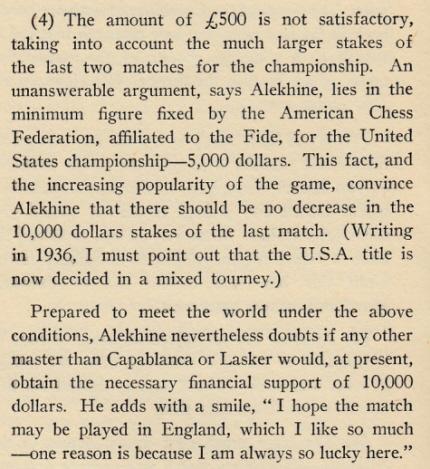
Alekhine’s attitude to stakes of $10,000 was not always so positive in other public statements, but it is a subject on which many authors have written simplistically. From pages 266-267 of The Batsford Book of Chess Records by Yakov Damsky (London, 2005):
‘[Capablanca] offered to “defend” his chess crown for a prize fund of ten thousand dollars, almost a fairytale figure by the standards of the mid-1920s. Without that sum, no claimant to the throne could even think of an audience with His Chess Majesty. “Capa has cut himself off from everyone by a wall of gold”, the newspapers wrote at the time, and indeed the stake appeared incredibly high. As often in this life, however, it was a case of “Vengeance is mine; I will repay.” When Alexander Alekhine did succeed in finding sponsors and wresting the crown, he agreed to give Capablanca a return match – on those same conditions of Capablanca’s.’
Matters are far more complex than that, and any writer should avoid the technique of vaguely attributing a quote in the singular to ‘newspapers’ in the plural.
The London Rules stated: ‘The champion will not be compelled [our emphasis] to defend his title for a purse below $10,000.’ The implications of that wording are often overlooked, and in a statement published on page 90 of the July-August 1926 American Chess Bulletin Capablanca himself wrote regarding the Rules: ‘Among other conditions, they call for a minimum purse of $10,000.’ This was quoted on page 194 of our book on the Cuban, and we remarked on page 319 that it was a surprisingly loose interpretation of Clause 8.
(8489)
Various aspects of the London Rules and the later rematch controversy were debated in C.N.s 415 (R.D. Picken), 918 (Hugh Myers), 949 (R.D. Picken), 1114 (Frank Skoff) and 1167 (C.D. Robinson).
For a discussion of the London Rules in the context of the 5-5 affair, see our feature article Capablanca v Alekhine, 1927.
To the Chess Notes main page.
To the Archives for other feature articles.
Copyright: Edward Winter. All rights reserved.